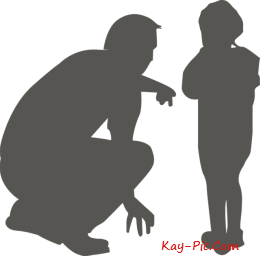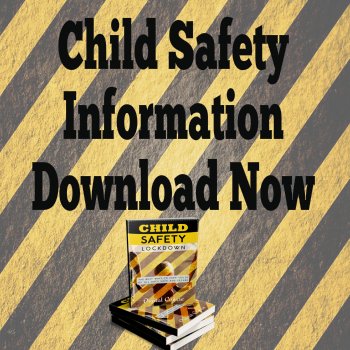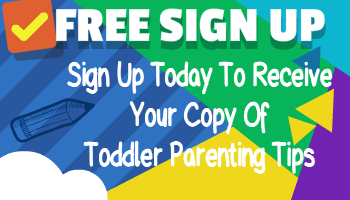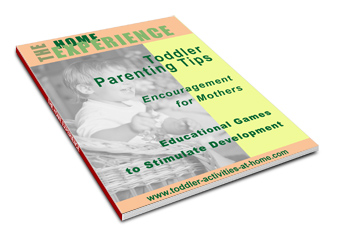How To Discipline A Toddler
This page explains how to discipline a toddler in four practical steps, teach them cooperation and self-respect, while making your life easier too.
You should use the steps outlined here along with the general advice given in the page on disciplining your child - go there now if you haven’t already done so.
So you see your toddler doing something they shouldn't. Assuming they
are not a danger to them self or others, here is the best way to respond:
Step 1
Positive Instructions
State clearly and in simple language what you want the child to do.
This may well be the end of the problem - perhaps the apparent 'bad' behaviour is actually curiosity or frustration. Go to understanding toddler behaviour for more details.
Avoid saying what they shouldn't do. So instead of: 'Don't pick that up!', say 'Give me the pebble'.
Naming the object and showing them what to do is also helpful because of their limited language - click here for more information on how the way you speak to your toddler can help their behaviour.
Be calm - the tot may be unaware they are doing anything wrong, and by shouting you teach them to lose their temper.
How To Discipline A Toddler
Step 2
The Positive Warning
So you have stated what you want your toddler to do, but he carries on regardless.
Here you start the real process of how to discipline a toddler.
Now is the time to threaten withdrawal of something pleasant. It must be something that he takes for granted and is expecting, like the trip to the park you told him about earlier, or playing in his sandpit.
Many parents do this, but phrase it in the wrong way. They say "Tidy up your toys or there'll be no park". Toddlers' limited understanding (plus their inability to problem solve) means that they might think that you have already decided that they cannot go to the park.
The Positive Warning, on the other hand, goes like this:
‘Do you want to go to the park?’
‘Yes’
‘Then you help me tidy up your toys first’
Do you see the difference? This way you get the child to affirm their desire to go to the park and you clearly communicate what you want them to do.
If he still doesn’t cooperate, just shrug your shoulders and say ‘Ok, no park’.
Still no success? Sooner or later he will want something from you – a drink, a hug, a cracker, a story. Whatever it is, say ‘tidy up your toys first’.
Wondering whether to use withdrawal of something pleasant or go for ignoring the behaviour?
I find that the look on my toddler's face is a good indication. If he is grinning at me with a challenging glint in his eye, this says to me I want to mess you around - won't that be a fun game? and ignoring is the only option.
Knowing how to discipline a toddler is all about trial and error. See what works best for you and your child.
Step 3
Time Out
This is when you isolate the child for a short period of time, and should be used when all else has failed.
I use it straight away for more serious incidents, such as aggressive behaviour. Go to time out to learn more. It's really important to do time out properly or it will backfire.
Step 4
Congratulate Your Toddler
Don't forget this step - it's a really important part of how to discipline your toddler.
Once your toddler has cooperated, it's important to congratulate them on doing the right thing.
Change your expression and become cheerful – this way you encourage them to repeat the good behaviour in the future.
It may seem odd to some people that praising a child for doing as they are told is one of the recommended ways of dealing with behaviour problems.
But think about it.
If you sink into a chair and mumble sarcastically ‘At last!’, you just confuse your child. How do they know they have done the right thing unless you make it clear?
Ignoring Problem Behavior
Some experts claim that if you want to know how to discipline a toddler, this is the most effective way.
They would tell you to not even bother with clear instructions and threatening to withdraw a privilege.
Pour cold water all over his plans for mischief by ignoring him.
Go to ignoring problem behaviour for more details.
A Final Word
Things Can Only Get Better
Can't They?
It is important to remember that when you are working out how to discipline a toddler, things might have to get worse before they get better.
Some problem behaviour is a response to emotional upheaval caused by a new brother or sister, or family break-up.
There are days when you feel exhausted and nothing seems to work.
You may have let your toddler get away with difficult behaviour up until now. A sudden show of the 'you mean business' variety will probably be met by stubborn refusal.
Whatever the reason for resistance, you have to just persevere, and ride out the storm while making as much quality one-to-one time with your toddler as is possible.
Another way to look at the question of how to discipline a toddler is to imagine you are the driving instructor and your toddler is learner driver.
Every learner driver wants a patient teacher – one who doesn’t hold a grudge when they make a mistake and is positive about even the smallest success. That’s what your toddler needs from you.
But remember that every driving instructor needs time and the room to make mistakes too. learning how to discipline a toddler doesn't happen overnight.
Keep doing your best - you will get there in the end.
To Help Busy Mums and Dads Here Are Some Related Shopping Items
When you purchase from this link, you are actually purchasing from Amazon.com, and you can have peace of mind that your order will be processed by Amazon’s secure order server.
Other Bible Crafts Just For You
Free Bible Crafts l Home l A light unto my feet l Seed Sower Parable Craft l Isaac Crafts l Joseph Crafts l Toddler Christmas Idea l Toddler Christmas Activities l Toddler Christmas Crafts Widows Mite Crafts l Abraham and Sarah Crafts l Prodigal Son Craft l God is watching craft l Samuel Bible activities l Jesus as a boy Bible activities l Lords Prayer Crafts l Daniel Bible Crafts l Noah's Ark Crafts l Fruit of the Spirit Craft l Church As A Body Craft l Fisher of Men Bible Crafts l Moses Bible Crafts l Fruit of the Spirit Craft l Toddler Creation Craft l Toddler Easter Activities l Celebrate Passover l Bible Friendship Activities l Jonah Whale Activity l Jesus Miracle Activities l Toddler Prayer Craft l Water into wine l











New! Comments
Have your say about what you just read! Leave me a comment in the box below.